Opening the Furo: Shoburo
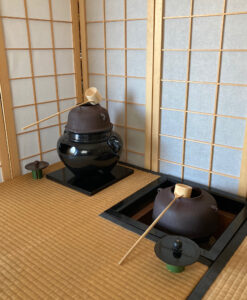
Photograph of a hypothetical arrangement of the relationship between the fu-ro, 風炉, wind-hearth, on the left, and the ro, 炉, hearth, on the right. This is to show the similarities and differences between them. The futa, 蓋, and the futa-oki, 蓋置, lid-place, for the furo, are to the left, whereas the futa and futaoki of the ro are to the right. This may be reflected in the ancient pair of Chinese lions that guard the entrance to the imperial palace, and other important places.
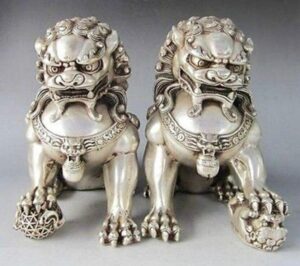
The male, on the left, has his right paw on a decorative ball, and the female, on the right, has a playful baby cub on its back under her left paw. It is believed that they keep away the evil spirits. The symbolic ball protects the world, the earth, while the female, with a paw on a cub, which is often depicted on its back, protects the dwelling, household, represents the element of spirit.
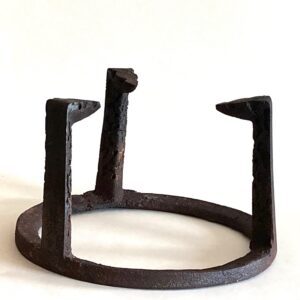
The fu-ro, 風炉, wind-hearth, has three feet, which is the most stable form of support, and is identified with Fire. The kama, 釜, kettle, in the ro, 炉, sunken hearth requires a support, which is usually in the form of a trivet, go-toku, 五徳, five-virtues. The lions, as guardians have four legs, however to accommodate a stable support, one of the legs must be dispensed with, and the solution was to have the creature put his or her paw on something. This resulted in having the male place his right paw on a globe, identified as the world, and the female place her left paw on an infant lion, identified as the household.
Changing from ro to furo occurs traditionally on May 10th. At Urasenke in Kyōto, Sho-bu-ro, 初風炉, First-wind-hearth, is the first official presentation using the furo, the portable brazier. The reason for having the furo returned to the Tearoom, may be related to deities who have their En-nichi, 縁日, Edge-day, on the 10th day of every month. They are listed below:
Nichi-gatsu-tō Myō-butsu, 日月燈明仏, Sun-moon-lamp Bright-buddha, a Buddha who preached the Lotus Sutra in a past life before Shakyamuni.
Kon-pi-ra Gon-gen, 金毘羅権現, Gold-help-spread Power-exist, guardian of seafaring, who is identified with Su-sa-no-o Mikoto, 素戔嗚尊, Elemental-revered-cry Lord.
Ama-terasu Ō-kami, 天照太神, Heaven-bright Grand-god, the Shintō Sun Goddess.
The appearance of the Buddha is a true auspicious occasion that is called the Vesaka Festival on May 10th, the day when the year 2561 in the Buddhist calendar, is the ‘Buddhist New Year’ for Buddhists. Buddhists celebrate this day with more enthusiasm than normal New Year’s.
Lunar months are divided into thirds: offerings are made on the first, eleventh, and twenty-first day. The tenth day is similar to observances made on the eve of a matsuri. Kagami biraki is observed on the 11th day of the first month, the New Year.
Japanese people also use 10-day periods called jun (旬). Each month is divided into two 10-day periods and a third with the remaining 8 to 11 days: The first, from the 1st to the 10th is jō-jun, 上旬, upper-season. The second, from the 11th to the 20th , is chū-jun, 中旬, middle-season. The last, from the 21st to the end of the month is ge-jun, 下旬, lower-season. It may be that the shoburo is first used on the 10th day of the 5th month in preparation for an event on the 11th.
The furo is traditionally located in the northwest corner of the Tearoom, which is the realm of Amida Nyorai, 阿弥陀如来, Praise-increase-steep Like-become, the Buddha of Compassion. Perhaps through no coincidence, Rikyū had a kama that was called the Amida-dō gama, 阿弥陀堂釜, Amida-hall kettle.
In depictions of Amida, a lion may be located in the base of the votive image.
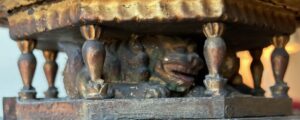
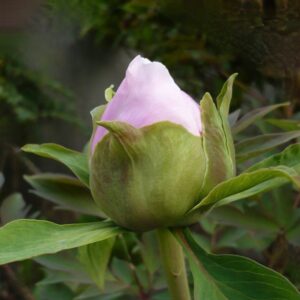
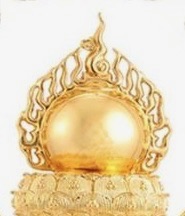
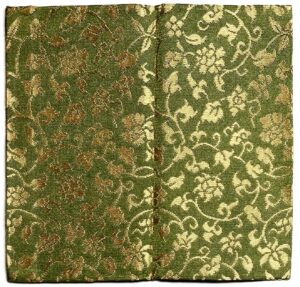
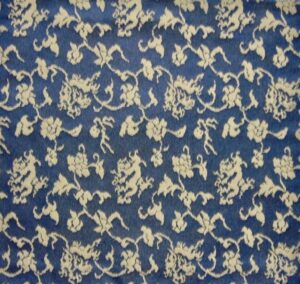
Two examples of the fabric pattern of bo-tan kara-kusa, 牡丹唐草, male-red (tree peony) Tang-grass, arabesque: the pattern on the right includes dragons.
Lions are fascinated by peonies. kake-jiku fabrics often have patterns of peony flowers, and frequently with vines, bo-tan kara-kusa, 牡丹唐草, male-red (tree peony) Tang-grass, arabesque. The bud / hōju is the beginning of enlightenment, and the fully open peony is enlightenment. All peonies have five or more large outer petals called guard petals and a center of stamens or modified stamens. Single forms have centers of pollen-bearing anthers and stamens.
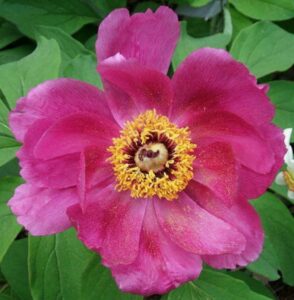
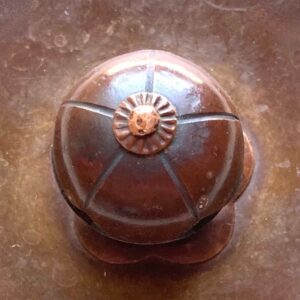
Perhaps the flower form of the kama lid tsumami is a botan, tree peony, and/or is not always the ume no hana. The small escutcheon with its small radiating lines resembles a kiku, 菊, chrysanthemum. The word kiku, flower, is a homonym for kiku, 聞, listen, perhaps to the matsu-kaze, 松風, pine-wind, sound of a simmering kettle. A traditional Chinese medicine is made from tree peony roots and bark.
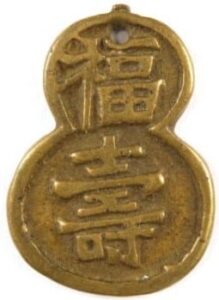
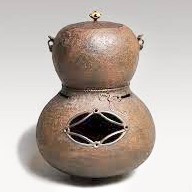
The bottle-gourd male flowers differ from female flowers, because the male flowers tend to form earlier, and the female flowers have a budding fruit at their bases. An essential procedure for healthy plants and flowers is pruning that in Japanese is called tsumami, 摘み, pinch. Just the petals are scattered on the ground to benefit the growth of the plants.The flower-shaped knob on many kama is also called tsumami, pinch.
The bottle gourd is sacred to Chinese Taoism, and is called in Chinese hu-lu, 葫芦, garlic-reed, Lagenaria siceraria, bottle gourd. The sound of the word in Chinese is hulu, which in Japanese, might sound like ‘furo’.
The Chinese word for gourd, hulu, 葫芦, has other auspicious associations as well. In some dialects, the character hu, 葫, has a similar pronunciation to fu, 福, fortune, which means happiness or good fortune. Therefore, saying hu-lu, 葫芦, for gourd would sound similar to fu-lu, 福禄, fortune-reward. The words ro, ashi, 芦, reed, and ro, 炉, hearth, both have the Kanji roku, 戸, door, for the sound ‘ro’.
In Feng Shui, 風水, Wind Water, in Japanese, Fū-sui, it is believed that gourds can ward off evil spirits, so that gourds are planted in the front and back of the house.
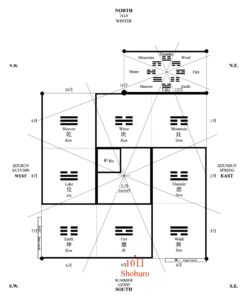
The Sho-bu-ro, 初風炉, First-wind-hearth, is traditionally presented on the 10th day of the 5th month, the date can be located with regard to the ideal yo-jō-han, 四畳半, four-mat-half, chashitsu; see the red dot on the diagram.

